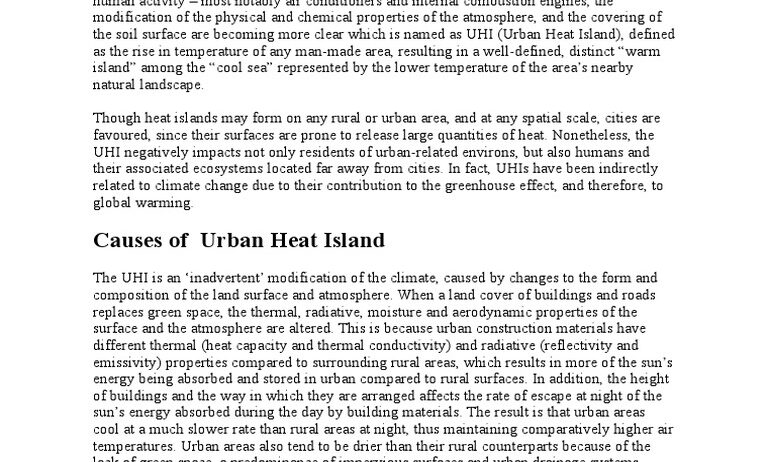Urban Heat Islands (UHIs) present a paradoxical phenomenon in climate science that raises crucial questions about the interplay between localized environmental effects and broader global warming trends. The concept is simple: urban areas experience higher temperatures than their rural surroundings due to a combination of human activity and infrastructural characteristics. However, understanding whether UHIs are merely a localized issue or a symptom of the larger global warming dilemma requires a multi-faceted exploration.
In essence, a heat island is a metropolitan area that is significantly warmer than its outlying rural areas, often due to human-induced changes. These changes can stem from factors such as concrete and asphalt materials that absorb and retain heat, decreased vegetation, and energy consumption that releases anthropogenic heat. The localized heating effect can elevate temperatures by as much as 1.8 to 5.4 degrees Fahrenheit (1 to 3 degrees Celsius) during the day, with differences even more pronounced at night. This phenomenon is not simply an inconvenience; it leads to alterations in local weather patterns, increases in energy consumption, and exacerbates air pollution.
While heat islands manifest conspicuously at a local level, it is essential to examine the underlying precipitating factors at the global scale. Urbanization trends show that more than half of the world’s population now resides in urban settings, a figure projected to increase significantly in the coming decades. This migration to urban areas intensifies the heat island effect through increased infrastructure, diversion of natural land, and localized air pollution, intertwining the phenomenon with broader global warming narratives. The direct correlation between the rise of urban sprawl and the intensification of the heat island effect is irrefutable.
A primary characteristic of heat islands is their reliance on the anthropogenic heat generated by industries, vehicles, and energy use. This heat contributes to global warming, as it increases the overall temperature and impacts local ecosystems. Moreover, this additional heat may exacerbate the effects of climate change, leading to more severe heatwaves, droughts, and intense storms. Herein lies a critical question: Can we disentangle the local impacts of heat islands from their global implications? The stark reality is that what begins as a localized issue, characterized by increased temperatures in cities, is inextricably linked to global climatic shifts resulting from climate change.
Urban environments also contribute significantly to greenhouse gas emissions, which are a primary driver of global warming. Studies indicate that cities are responsible for over 70% of carbon dioxide emissions worldwide, primarily due to energy consumption for heating, cooling, transportation, and industrial processes. This stark reality connects the localized heat islands directly to global warming, reinforcing the idea that policies aimed at addressing UHIs must also consider global environmental strategies. Initiatives such as tree planting, green roofs, and urban cooling strategies serve not only to alleviate local heat but also to curb emissions that contribute to global temperature rise.
Furthermore, the health implications of urban heat islands serve as another pivotal connection between local and global issues. Increased urban temperatures correlate with higher rates of heat-related illnesses and fatalities, exacerbating public health crises. Vulnerable populations—such as the elderly, children, and those with pre-existing medical conditions—are disproportionately affected by heat exposure. Consequently, elevated heat in urban areas reflects an urgent social justice issue, highlighting how environmental degradation impacts marginalized communities. Addressing health risks on a local level translates into a reduction in the broader economic and social burdens associated with climate change.
Interestingly, the urban heat island effect does not affect all communities equally. Socio-economic disparities play a crucial role in determining how heat islands influence different populations. Wealthier neighborhoods often have access to resources that enable the implementation of green infrastructure, such as parks and shaded areas, effectively mitigating the UHI effect. Conversely, less affluent areas may confront inadequate infrastructure and a scarcity of green space, leaving these communities vulnerable to the adverse effects of heightened temperatures. This disparity underscores that while heat islands may appear as localized phenomena, they are fundamentally entwined with systemic socio-economic conditions and contribute to broader discussions about equity in the context of climate change.
In conclusion, understanding the phenomenon of heat islands demands a nuanced approach that transcends the local versus global dichotomy. The effects of Urban Heat Islands are both profound and far-reaching. They manifest with tangible impacts on microclimates while simultaneously contributing to global warming trends through the complex interplay of urbanization, anthropogenic heat, and greenhouse gas emissions. The challenges posed by heat islands call for comprehensive strategies that integrate local responses with global climate initiatives.
As cities continue to expand, innovative solutions aimed at reducing the UHI effect, improving city planning, and fostering green infrastructure become paramount. Strategies like the creation of urban green spaces, implementation of reflective building materials, and promotion of energy-efficient technologies are crucial not only for alleviating local heat but also for mitigating the global climate crisis. Awareness, policy action, and community engagement are essential instruments in addressing the heat island effect as a critical component of the global climate narrative—a narrative that mandates immediate and systemic change to secure a sustainable future.







